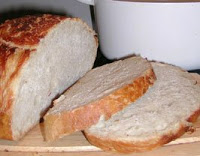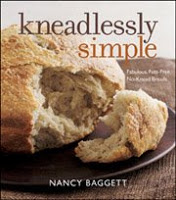
I am excited to say that my new book, Kneadlessly Simple, is about to reach a high water mark–100 consecutive days on the Amazon list of top selling cookbooks! I have been getting a lot of e-mails from people telling me they are happy with the book, and also from folks with questions that I’ve answered. Since many bakers out there may benefit from the Q & A’s, I’m going to post some of them here. (I’ll be posting some more in a few weeks). But first, just let me share a couple of the many compliments that have been so gratifying:
“I have fallen in love with your breads and techniques.”
Q: I’ve been baking your breads and am very happy with them, but my Grandma (she used to be the big baker in the family) thinks they come out looking too brown. Am I doing something wrong?
Actually, deeper browning is a hallmark of today’s artisan-style breads. Some professional artisan bakers insist that deep browning is essential to creating a fine loaf. (One well-respected baker I know even posted a note in his new establishment telling customers that his breads were not over-baked, that the darker color meant they would have more flavor.) He’s right to a point, but I feel this is also a matter of personal taste. If you (or your grandmother) like less browning, just lower the baking temperature 25 degrees F from what is recommended in the recipe. Also, cover ing the loaf top with foil (shiny side out) halfway through baking will slow the browning process.
Q: Your recipes all feature a long, slow rise, so why do I need to use “fast-rising” yeast?
Q: I’ve baked several Kneadlessly Simple breads, including the basic loaf. I loved the flavor but it got too brown on the bottom. The buttermilk bread also browned a lot, both on the top and bottom. Any suggestions?
A: The buttermilk bread browns more than many loaves because milk products are sensitive to heat. If the baking pot you used was dark inside, it absorbed heat particularly efficiently, which resulted in even more browning. I suggest setting the oven to 425 degrees F to preheat, and then turning the oven down to 400 degrees F to bake. If it’s convenient, you could also switch to a pot with a light-colored or shiny interior.
I assume you mean the White Peasant-style Pot Boule by the ‘basic” loaf. I have both pre-heated the pot and baked this bread at 450 degrees F a number of times without problems. However, I found that in pots with dark-colored interiors, the bread tended to over-brown on the bottom, so I changed my instructions and suggested baking at 425 degrees F. Although this worked in my ovens and pots, it apparently doesn’t in yours. Try dropping the temperature to 400 degrees F for baking and see if that helps. To curtail bottom browning more, try moving the loaf to the middle oven rack. In most ovens, the closer the pot is to the bottom, the browner the loaf bottom will get.
Beating Instead of Stirring?
A: Yes indeed! The Kitchen Aid works just fine. You can just dump everything into the big bowl, then mix in the liquids with the paddle—use low speed. Then, just scrape down the bowl and use it for the rises. The second stirring is usually brief, only long enough to deflate, although in cases where powdered milk or egg are added, they can be mixed in with the Kitchen Aid also. You will likely need to switch to the dough hook, as the dough is rubbery from the gluten development at this stage.


Thanks Bobbi! Delighted to hear you are enjoying my book. If the paper is on-line and you can send me the link, I’d love to see the story. I don’t know where Harrodsburg is….
Congrats! I love your book! I just did a book review for my local newspaper, The Harrodsburg Herald and now there is a waiting list for the book at the public library.
congratulations, Nancy!